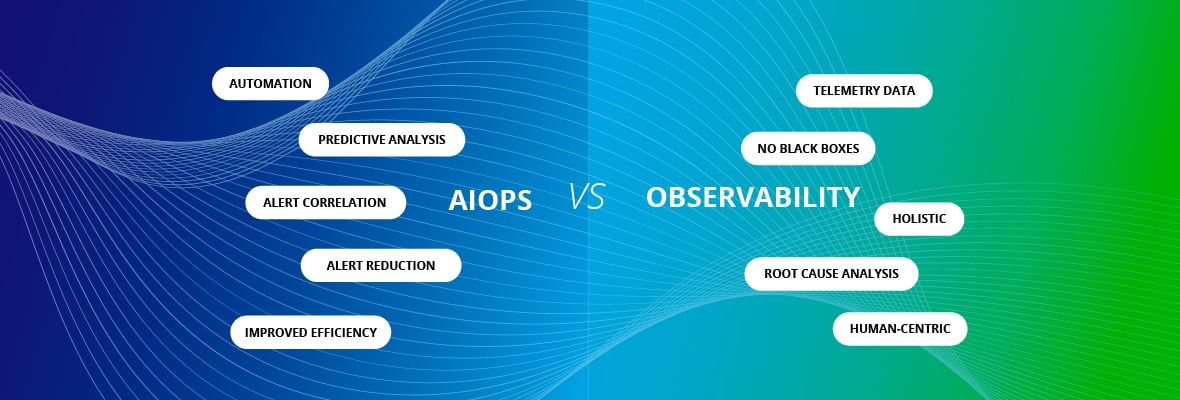In the ever-evolving world of IT, keeping an eye on application, service and system performance and addressing issues in real-time is crucial both to an organization’s customer experience, as well as its overall success. Two terms and approaches that have gained significant attention in recent years are AIOps and observability. While they both relate to improving IT monitoring and management, they serve distinct roles in enhancing operational efficiency. In this blog post, we'll dive into the differences between AIOps and observability to help you better understand their unique contributions to the world of IT and business operations.
What is AIOps?
AIOps, or Artificial Intelligence for IT Operations, is a paradigm that combines artificial intelligence and machine learning with IT operations to automate and enhance various aspects of the IT environment. The primary objective of AIOps is to improve IT and system operations by leveraging automation and predictive analytics.
Here are some key characteristics of AIOps:
Automation: AIOps uses machine learning algorithms to automate routine and repetitive tasks, such as root cause analysis, anomaly detection, and incident resolution.
Predictive Analysis: AIOps employs predictive analytics to anticipate issues before they become critical outages or slowdowns, helping teams proactively address problems.
Data Integration & Correlation: Data is gathered from various sources, including events, logs, metrics, and traces, and this information is correlated to provide a more holistic view of the complete IT environment.
Alert Reduction: By filtering out alert noise and false alarms, AIOps reduces the number of alerts, enabling IT teams to focus only on important issues and incidents.
Improved Efficiency: AIOps improves the overall efficiency of IT operations by minimizing downtime, enhancing performance, and reducing the mean time to repair (MTTR) issues.
What is Observability?
Observability, on the other hand, is a concept that revolves around the idea of gaining insight into complex systems by analyzing their outputs, without necessarily knowing their internal workings. It emphasizes the ability to understand and diagnose system behavior and performance through the collection and analysis of telemetry data.
Here are the key facets of observability:
Telemetry Data: Observability relies on collecting various types of data, including metrics, events, logs and traces, to create a comprehensive and complete view of a system.
No Black Boxes: It emphasizes understanding a system's behavior without needing full insight or visibility into its internal components, making it suitable and usable for modern, complex microservices architectures.
Holistic: Observability provides a holistic view of an application's performance, allowing developers and operations teams to see how different components interact and their interdependencies.
Root Cause Analysis: With the help of detailed telemetry data, observability makes it easier to pinpoint the root cause of issues and optimize system performance.
Human-Centric: Observability empowers teams to better understand and troubleshoot issues by providing data that is human-readable and easy to work with.
Key Differences between AIOps and Observability
Now that we've explored the basics of AIOps and observability, let's highlight some of the key differences between the two:
Automation vs. Insight: AIOps is primarily about automation and predictive analysis, while observability focuses on gaining deep insights into system behavior.
Proactive vs. Reactive: AIOps is proactive in preventing issues before they occur, whereas observability is more reactive in diagnosing and understanding problems that have already happened.
Complexity Handling: Observability is particularly valuable in complex, distributed systems, as it doesn't require an extensive understanding of each component's internal workings.
Data Volume: AIOps often deals with large volumes of data but seeks to minimize noise, whereas observability aims to capture as much data as possible to provide a complete picture of a system’s performance.
Use Cases: AIOps is used for automation and reducing the operations management burden on IT teams, while observability is used for troubleshooting, debugging, and improving system performance.
Conclusion
AIOps and observability are both vital tools in the IT operations and software development toolbox, but they serve different purposes. AIOps focuses on automation, prediction, and efficiency, while observability is all about gaining deep insights into system behavior and performance. Observability data can feed AIOps systems, giving them a more complete view of system and application health. AIOps systems can then take action on that data to reduce alert noise, anticipate and prevent outages and automate IT processes.
Depending on your specific needs and goals, you may find one or both of these concepts invaluable in managing and optimizing your IT infrastructure, applications and services.
To Learn More About OpsRamp’s AIOps and Observability Capabilities, Please Visit: https://www.opsramp.com/solutions/aiops/ and https://www.opsramp.com/solutions/hybridobservability/
Next Steps:
- Read the blog: How OpsRamp Closes the Complexity Gap with Distributed Tracing
- Read the blog: How OpsRamp Log Management Helps You to Find and Fix Issues Faster
- Read the Case Study: Tietoevry brings multi-cloud AIOps to Nordics with OpsRamp
- Schedule a custom demo with an OpsRamp solution expert.
- Follow OpsRamp on Twitter and LinkedIn for real-time updates and news from the world of IT operations.






